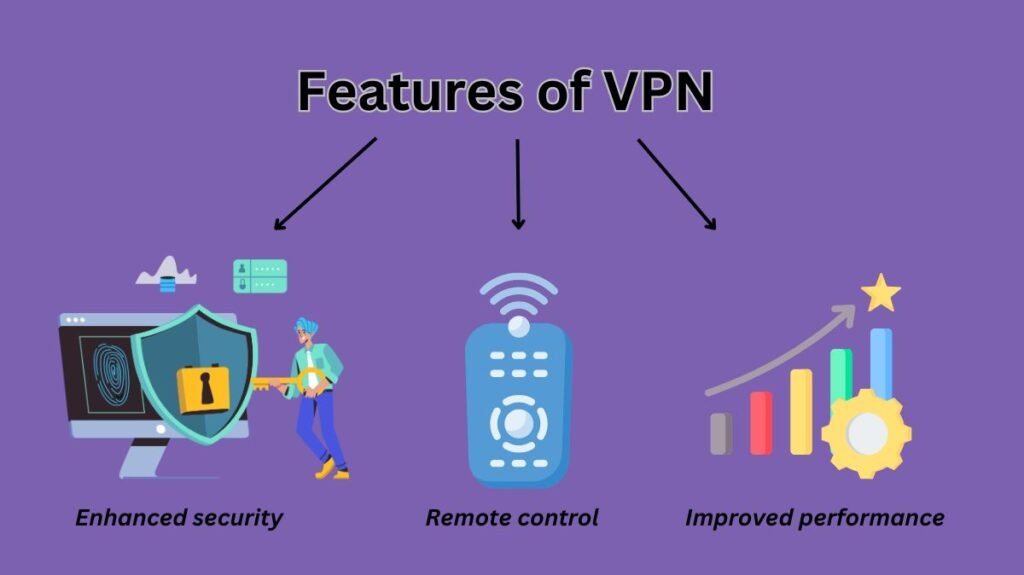Components of VPN

A virtual private networks offers remote access via a client-server architecture. Remote users’ connection requests are handled by a VPN server. They are sent to the corporate office’s LAN following authentication.
A VPN’s constituent parts are:
VPN server
Handles distant VPN customers’ connection requests. It serves as a gateway between a private network and VPN clients. To avoid network delay, large networks with numerous requests could require multiple VPN servers. One virtual interface of a VPN server faces the corporate office’s LAN, while the other virtual interface faces the Internet. Connection requests are actively received by this interface.
VPN client
Notifies the VPN server of connection requests. A telecommuter may utilize a laptop or a remote PC to connect to an ISP’s local POP. It may also be a computer in a branch office or a business partner’s office that is connected to the local area network (LAN).
VPN connection
Offers a safe connection across the transit network. It is comparable to two computers connected point-to-point. A VPN connection’s two endpoints are where data encryption is carried out.
Tunnel
To enable datagrams to be sent via an IP-based network, such the Internet, a tunnel encapsulates the data.
Tunneling protocols
Communication standards known as tunnelling protocols make it easier to build secure tunnels across open networks. The most popular tunnelling protocols are IPSec, L2TP, and PPTP.
Tunneled data
VPN servers send data to customers via secure tunnels. A variety of encryption techniques are used to encrypt the data packets before to transmission.
Shared or public network
The transit internetwork in a VPN is represented by a shared or public network. It may be an Internet Protocol (IP)-based intranet or a public or shared TCP/IP network, like the Internet.
VPN Vendors and Products
VPN services can be purchased or used for free. However, paid vendor solutions are more frequently suggested than free ones. Among the VPN providers are the following:
- NordVPN has a sizable server collection and a robust set of security measures. While upholding a strict stance on user privacy, NordVPN offers services like Tor browser connections for anonymous web browsing.
- Most operating systems provide an app for Private Internet Access VPN. This gadget can connect to an endless number of smart TVs, PCs, and phones. Although it lacks advanced features and privacy precautions, it remains a reliable VPN service.
- A wide variety of dispersed servers make up ExpressVPN, a VPN service. It has robust information security and privacy policies. It leverages the OpenVPN protocol and provides additional capabilities like split tunnelling.
VPN Examples
Connecting two or more networks securely is possible using a virtual private network (VPN). Here are a few VPN examples:
- Linking a headquarters to a branch office: A Nevada bank branch can exchange resources like bank statements and mortgage information with its Texas headquarters by connecting over a virtual private network (VPN).
- Linking a remote employee to an organization’s network: A VPN can be used by a distant worker to access restricted programs or the company’s internet.
- Connecting a company’s many offices: A company with operations in New York City and Los Angeles can share data over VPN.
- Connecting a personal device to a company network: VPNs allow employees without company laptops to access the network.
Features of VPN

Essential Features of a VPN Data transport and secure communications are the main benefits of VPNs. This technology has a lot of additional features.
Enhanced security
A VPN’s main aim is to encrypt data to prevent hackers. Due to the epidemic, worldwide work-from-home (WFH) has grown, as have security costs.
Microsoft discovered a huge phishing effort that used 2,300 distinct web pages attached to mails in only one day. These communications took the shape of financial compensation information related to COVID-19. A phoney Office 365 sign-in page was the end result.
Remote control
Working remotely was never as crucial as it is now. In late 2020, 75% of employees could anticipate to increase their remote work hours by 35%, according to a Gartner report Opens a new window. No matter where a person works, they may safely use a VPN from a distance. Therefore, when file sharing becomes safer, a company’s productivity stays the same or even increases.
Improved performance
It’s crucial to realize that, regardless of the size of your company and the services you need, the first investment in VPNs is nearly always reasonable. The figures show that more businesses are willing to allow their workers to work from home.
Additionally, the VPN solution may be expanded to accommodate your company’s expanding needs. VPN is a technology that may improve any company’s financial performance, mainly by guaranteeing business continuity. Then, regardless of their location, it offers a secure environment that remote workers may readily access.
VPN security
Unless there is a VPN connection procedure needed to evaluate the connected device’s condition, each device that uses a VPN to access an isolated network runs the danger of introducing malware into that network environment. Attackers with credentials they have stolen can access network resources, such as switches and routers, if the connected device is not inspected to see if it conforms with an organization’s security policy.
To lessen possible attack surfaces, network administrators should think about including software-defined perimeter (SDP) components into their VPN protection infrastructure in addition to VPNs, according to security experts. Large and medium enterprises can adopt a zero-trust paradigm for access to on-premises and cloud network environments by using SDP programming.
Why do businesses use VPNs?
A safe, fast, and affordable method of connecting distant users to the office network is through virtual private networks, or VPNs. VPN connections can be more affordable and provide more bandwidth than dedicated WAN (wide-area network) lines or long-distance, remote-dial links since they are often established via the public internet. In contrast to costly, dedicated LAN or WAN (wide-area network) lines or long-distance, remote-dial communications, VPN connections give businesses high-bandwidth, private Internet access.

